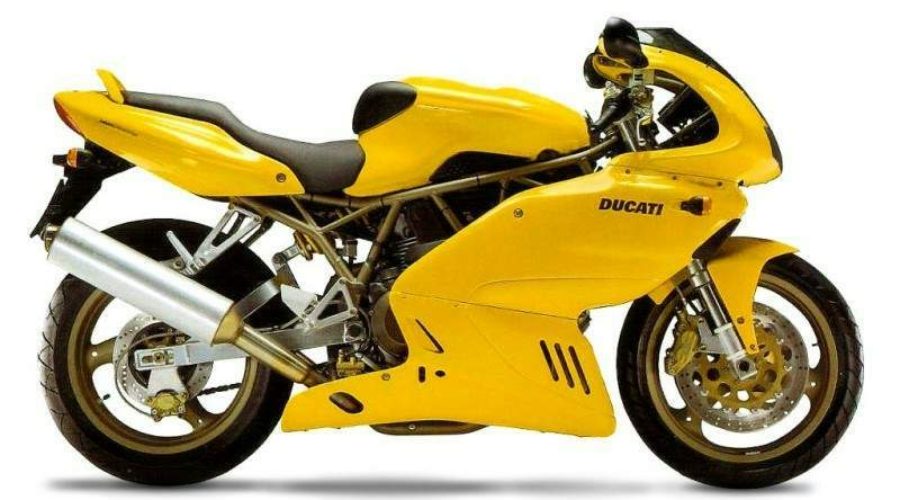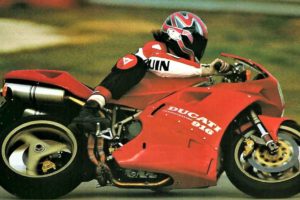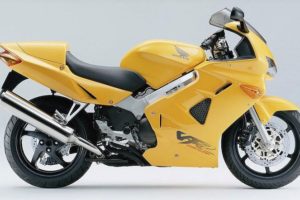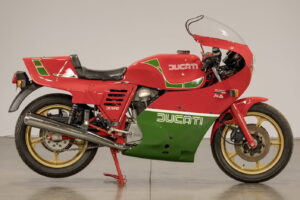1998 Ducati 900SS
Ducati’s 900SS had it all its own way for years. Only Ducati understood the joy of a compact, simple, large capacity sporting twin. Character, individuality, stirring if humble performance, compact dimensions – a lovely recipe which attracted the buyers it deserved.
Then the Japanese twigged to it. TRX850, VTR1000, TLI000S. Suddenly the 900SS, a veteran of 1991, was old and tired, a crude Italian which didn’t really stack up dollar-for-dollar against the newcomers unless you really wanted a Duke.
Buyers still did want the Italian job, but not enough.
Besides, Ducati was in the hands of American marketers. It was time to move up in the world.
The ST2 introduced the new age Ducati, and now it is time for the 900SS to push the envelope further and persuade millions that Ducati is the only choice for contemporary buyers who demand performance and tradition at the same time. It’s not a role to envy, but it’s one the SS embraces boldly.

A new look, better handling and stronger performance take the SS to higher levels in nearly every way. The SS was always greater than the sum of its parts, and a few tweaks all-round have made the calculation even better.
It only took 15 months for the factory to come up with the new model. Ducati credits this to investments in R&D, a more efficient design process, and more staff. At the same time Ducati claims an improvement in quality, and has included previously unheard-of phrases in the literature, such as “customer satisfaction” and “product quality”. Imagine that ten years ago.

Ducati’s chief of design, Pierre Terblanche, said he “imagined a classically styled alternative to the existing array of high-revving four-cylinder race replicas”.
It’s an odd thing to say because there’s no way you’d call the flash 900SS classically styled. Most styling cues are drawn from the Supermono, and comments vary tremendously.

The purists don’t like it — too modern, too Japanese, too ugly, especially with that lower fairing reminding them of the old 900 S2 which never found a place in the hearts of Ducatisti.
Younger players love it for its sexy lines and sleek profile. Some see a woman’s curvaceous body in the 900SS; one wag countered that it had to be silicon enhanced.
You can walk around this bike and not find a single blemish unless you look hard. The little rubber piece above the headlight doesn’t fit perfectly. If you’re really picky you could say the awkward join of the rear end of the bodywork isn’t precisely lined up, and the tail gently rubs the rear light. Not big issues. This is the best finished Ducati we’ve seen, and it’s a match for the Japanese.
That is a big issue.
You will delight in the details. The brake and gear levers are lovely little things, for example, and the big tankpad is a sensible, practical addition.

The first gentle ride on the new SS brings more joy. Even in the higher gears, the engine lopes down to less than 2500 rpm and then pulls without the dreaded snatchiness most Ducati V-twins have. Electronic fuel injection replaces the old model’s Mikuni carbs to provide a better fuel/air mix to the cylinders, and new camshaft profiles keep the valves open for longer.
The new bike’s powerband is what a twin’s should be. Wide. The climb from low revs through the midrange and to the rev limiter, which cuts in just before 9000 rpm, is smooth and strong. The secret to the beautiful power delivery is the torque figure, which never falls below a measured 70Nm from just after 4000 rpm, to nearly 8000, hitting 79Nm at 7000 rpm. The old model managed 72Nm at best. Power peaks at 8000 rpm, and drops away after that.

This bike is no roadburner, with a meagre 56kW maximum power output measured at the back wheel, making the claimed 59kW at the crank look conservative. Its measured performance is almost identical to a TRX850, and no match for the VTR1000’s measured 75.3kW, but this is a supremely useable engine, especially on the road.
It never feels weak, although it’s not exactly quick to rev out either. It pulls a higher gear than a four-cylinder bike out of corners or is happy to rev high and drive harder. Top speed is not far beyond 200km/h, where acceleration slows.

It’s perhaps not the sort of performance you’d expect to thrill at a day out on the race track, but it’s a hell of a lot of fun because you can use it to its limit without having to be an A-grade road racer. And it is still quick, thanks to a very sporty chassis.
The 900SS has the sportiest chassis of all the road-targeted twins. The eightvalve Dukes and the TL1000R Suzuki are in another league, but the 900SS is streets ahead of the VTR, TRX and TL-S for sports handling.
The frame is a modification of the traditional trellis used before, but a lot has happened in tyre and suspension technology since the previous SS appeared in 1991, and Ducati has used this to shorten the wheelbase to 1395mm from 1420, reduce the rake by a degree to 24 degrees and the trail by 3mm to 100mm. Stability and cornering are better than ever.
The stiffer chassis and other changes have increased weight from a claimed 186kg dry to 188kg, which is nothing you’d notice. However, the wheels are both lighter (400g front and 900g rear), and this lower unsprung weight compounds the effects of the quicker geometry.
Typically taut suspension sits at both ends of the Ducati. The rear is still the rather crude cantilever set-up with some progressiveness built in and, for 1998, the suspension unit has a longer, 71mm stroke (up from 65mm) to ease its burden. The Showa forks are 2mm thicker at 43mm for increased rigidity, and are aided by an axle of 25mm diameter (up from 20mm).
This new Duke loves flicking into corners. It dives in quicker than before and with plenty of confidence and feedback. There’s a ton of cornering clearance. The Michelin Hi-Sports stick like glue and are not stressed by the power delivery when you get on the gas out of the corner. As you’d expect, the SS has a distinct advantage in being able to get on the power very early in a bend, well before a typical four-cylinder bike.

Unlike most modern sportsbikes, the 900SS has a slightly rearward weight bias. More weight on the front might keep it more planted over bumps, especially when accelerating hard. The stiff suspension, even with the compression damping wound right back, tends to hit bumps hard, and the front end shakes and shimmies on country roads. It rarely threatens to get serious, but the SS lacks the comfortable, bump-absorbing plushness of most Japanese bikes. Ideally the suspension would be a little more compliant. There’s no need for the SS to be as firm as the 916.
The brakes are excellent. Updated versions of the same Brembo brakes are used. The rear is not as weak as it used to be but it moans annoyingly in traffic. The front brakes, redesigned at the caliper and the lever, feel heaps better than before, and come on very progressively with huge stopping power. Impressive. Braking stability is good, and the SS, on its sporty front end, brakes very deep into corners.
As critical as good brakes is a gearbox that lets you step down the gears quickly and efficiently while hard on the anchors, and then is equally good going back up the ratios. Ducati did a lot of work on the shift action for this bike. The only trouble on test, and the opposite was noted by Roland Brown on the launch bike, was a reluctance to snick easily into neutral.

Going flat chat up the gears at maximum revs is as light and fast as a good Japanese gearbox, and coming down again is great too. There is not a single false neutral to report from the test. But the neutral light still lies sometimes, so it pays to be careful, especially when starting the bike on that stupid, spring-loaded side stand.
Ducati reckons high quality components have made the engine more reliable than ever, but it feels like the clutch is still a disposable item. Perhaps it may last better than the typical 20,000 km expected from the last model. Its worst habit is an inability to engage smoothly for a fast start. Instead it snatches and judders and is still heavy enough to be a hassle in town.
So is the riding position, a racing crouch that strains wrists and neck. The 900SS likes cruising at about 140 km/h to balance your body weight on the incoming wind that flows smoothly past the fairing and screen, but it is a struggle for touring at legal speeds.
On the other hand the bottom half is fine; the seat is okay and the footpegs don’t cramp your legs too tightly. The slim-line fuel tank is perfect to wrap your legs around and hang onto, particularly under brakes.
The fairing has simple ducting inside which directs cooling air around the engine and seems to do an excellent job. The oil temperature gauge – water cooling hasn’t complicated the SS engine yet – never strays towards the hot zone, at least not in the mild weather during the test.
The mirrors aren’t much chop, vibrating freely and requiring careful adjustment to avoid being filled with your elbows. The dash is simple and effective, and you quickly realise you don’t need a red zone marked on the plain tacho. Hand levers are both adjustable and there’s a tiny bit of storage space under the seat. Carrying other luggage will be easiest with a seat bag or a tank bag, but if you protect the rear panels well enough you’ll fit decent saddlebags across the back seat.
Terblanche says the new 900SS was designed to “most importantly offer more sheer fun than anything in its class”. Unless you like the power of the VTR or can’t live with the discomfort of the SS in times of humdrum riding, you’d have to agree. The 900SS is a big step forward on the old model, bringing its performance up to the standard we require now, and maintaining the flavour.
The 900SS’s price hasn’t changed with the new model, making $17,995 look very tempting. You can buy better performance for less, but owning a Ducati brings a cachet and self-satisfaction that many don’t get from Japanese motorcycles. And you’re definitely buying better performance than you could with the old SS. The concept is the same, but the right changes to the right areas have reaped rewards which make this Ducati so much better.
By Mick Matheson. Two Wheels, October 1998

Ian Falloon is one of the world’s foremost motorcycle historians and valuers, with a particular passion for Ducati. He has written many books on the marque, including The Art of Ducati, to which Pierre Terblanche wrote the Foreword, included below. You can see Ian’s extensive range of titles, and get in touch with him if you would like to purchase, here.


Terblanche: The Art of Ducati
I first met Ian Falloon at the Ducati factory in Bologna more than 15 years ago.
It is therefore is a privilege and great pleasure to have been asked by him to write a foreword for this wonderful new book on the motorcycles of Ducati.
Art indeed.
I grew up in a small town in South Africa called Uitenhage, which is known for its Volkswagen factory and a baboon called Jack, who was formally employed by the South African railways as a signalman.
So who then could have ever imagined that many years later I would be fortunate enough to end up in Italy as Design Director for Ducati where I would be responsible for the creation of many new motorcycles. Some of which, like the 888SPS, Supermono, 999R, MHe900 and the PS1000 are featured in this book.
The first time that I remember seeing a Ducati was in an issue of Cycle magazine (now Cycle World) circa 1973. It was love at first sight.
But when Cook Neilson won the Daytona 200 against all odds against the best in the world in I977 on a home built Ducati bevel drive called Big Blue, I was smitten.
A year later Mike Hailwood won the TT at the Isle of Man on the Steve Wynne 860 and my love turned into obsession. I became a Ducatista.
In those days Google and the internet were still far-out ideas in the minds of science fiction writers, so our access to information was extremely limited. The highlight of my week was a trip to the Central News Agency to pick up my copies of MCN and Cycle Magazine, my all-time favorite. We lived our motorcycle dreams through the articles and photos in these magazines.
These days it is very different. Many great books are being published every year so we have a huge choice. The many previous books by Ian Falloon hold a special place in my collection but this time he has outdone himself.
I have been a designer and student of motorcycles and design for as long as I can remember and it is always enjoyable and fascinating to rediscover the old favorites in a great new book. The motorcycles selected by the author are wonderful and shows that Ian really knows his Ducatis.
To top that off the pictures by photographer James Mann are beautiful.
It is my hope that all of the readers will enjoy this book as much as I have enjoyed the previous works by Ian. Happy reading, studying and dreaming.
By Pierre Terblanche.

Brad Black, aka Brad the Bike Boy (above), is Melbourne’s go to bloke for Ducati advice, servicing, fixing of things and performance upgrades at his workshop in the suburb of Oakleigh. He is also generous enough to share much of his knowledge on Ducati (plus Moto Guzzi, BMW, Aprilia and MV Agusta) at his website, https://www.bikeboy.org/ where you’ll find several of his technical reports on the 1998-2002 900SS engine.




